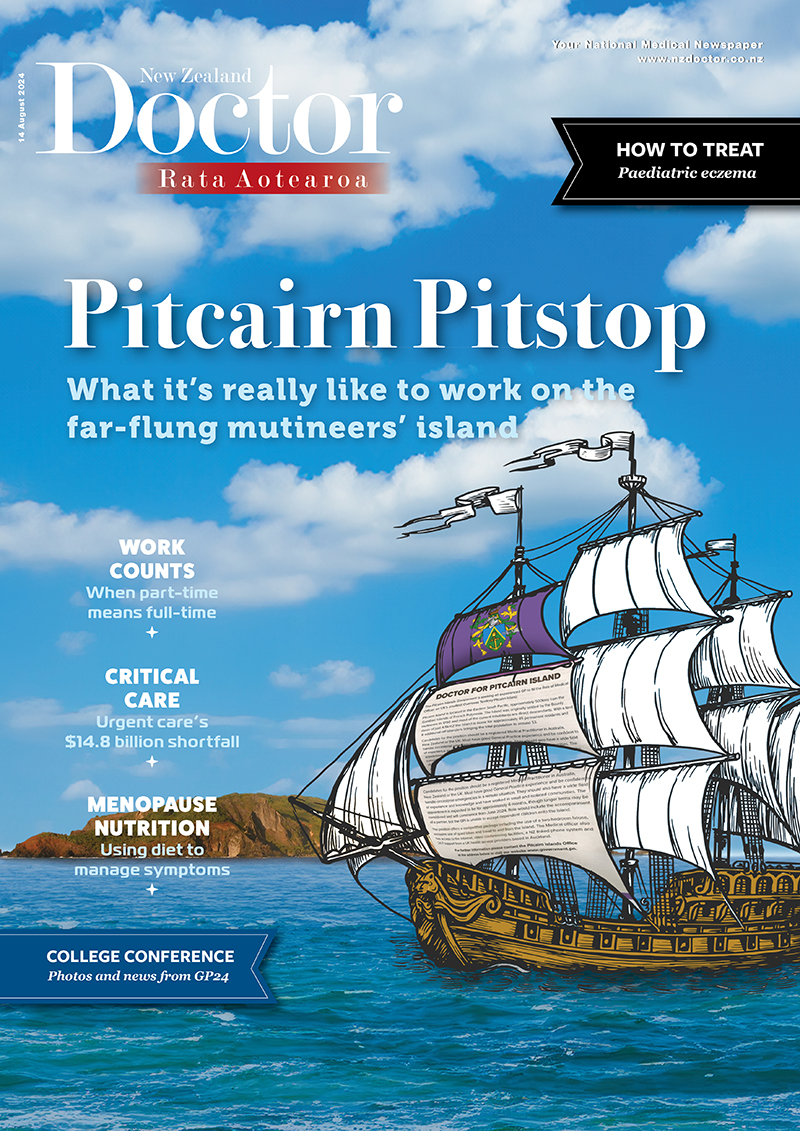Specialist GP Nikki Vadgama provides some tips to make your next paediatric eczema consult easier. She includes a review of new guidelines, resources, websites and medications for paediatric eczema management
See the improvement with tailored treatment of dry eye disease
See the improvement with tailored treatment of dry eye disease

Following on from last month’s article on the diagnosis of dry eye disease, this article discusses treatment, with a focus on the appropriate therapies for evaporative dry eye and aqueous-deficient dry eye
- For all types of dry eye disease, managing modifiable risk factors is the first step in treatment.
- Most patients will have evaporative dry eye related to meibomian gland dysfunction, which can be treated with warm compresses, omega-3 fatty acid supplementation, azithromycin (or doxycycline) and artificial tears.
- Artificial tears are the main treatment that can be offered to patients with aqueous-deficient dry eye.
This article has been endorsed by the RNZCGP and has been approved for up to 0.25 CME credits for continuing professional development purposes (1 credit per learning hour). To claim your credits, log in to your RNZCGP dashboard to record this activity in the CME component of your CPD programme.
Nurses may also find that reading this article and reflecting on their learning can count as a professional development activity with the Nursing Council of New Zealand (up to 0.25 PD hours).
In our previous article (see “Eye health”, New Zealand Doctor, 17 August), we discussed the diagnosis of dry eye disease (DED) and its classification into evaporative dry eye (EDE) and aqueous-deficient dry eye (ADDE). It can be difficult to classify DED as either EDE or ADDE in GP practice because specialised equipment is required to make a definitive diagnosis, but treatment should be tailored to the type of DED.
The previous article discussed some practical diagnostic tests that can be carried out in general practice. As a rule of thumb, most DED patients will have EDE related to meibomian gland dysfunction (MGD). A study of 224 patients with DED found only 10 per cent were classified as having purely ADDE, whereas 86 per cent demonstrated signs of MGD.1 Furthermore, of patients with significant ADDE, only 10 per cent are likely to have Sjögren syndrome.2
For all types of DED, managing modifiable risk factors is the first step in treatment. Computer use is strongly linked with DED.3–6 Patients should be counselled on reducing computer screen time when possible, and on taking breaks and performing blinking exercises to reduce the drying effects of computer use on the ocular surface.
Air conditioning and environments with low humidity can also contribute significantly to DED.7 Increasing humidity by reducing air conditioning or using humidifiers can be beneficial. Using an oil-based eye drop, such as Systane Complete, can reduce the effects of adverse environments.8
Contact lens wear is another significant modifiable risk factor for DED.9 Dryness is reported in 40 per cent of people who wear contact lenses, and 25 per cent experience moderate to severe symptoms,10,11 leading to decreased wearing times.12 In fact, the tear film on top of the contact lens has been found to more closely resemble that found in patients with Sjögren syndrome than the normal tear film, in terms of stability and behaviour.13
If the DED patient wears contact lenses, referral to their optometrist is warranted to assess whether changing the lens material or modality (eg, from monthly to daily disposables) may be beneficial. The optometrist may also recommend reducing contact lens wear or taking a contact lens holiday to allow the ocular surface to stabilise.
Some medications, such as antihistamines, antidepressants, anxiolytics as well as isotretinoin, have been consistently linked with DED.14
The GP is in an ideal position to check whether medications can be altered to help a patient’s DED.
Warm compresses are very effective in the treatment of meibomian gland dysfunction, even in cases of severe gland dropout
Warm compresses use a heated material (eg, eye mask or wheat bag) that is placed on the closed eye for a period of time, followed by digital pressure on the upper and lower lids. Warm compresses are very effective in the treatment of MGD,15–18 even in cases of severe gland dropout.15
Treatment should be between five and 10 minutes in duration, and performed a minimum of once, but preferably twice, each day.15,17,19–21 It takes at least two weeks to see an improvement in symptoms, and four to eight weeks to see improvements in clinical signs of dry eye.
Hot flannels are not effective as warm compresses unless the “bundle method” is used (see tinyurl.com/DED-WarmCompress for more information on this technique).18 If a wheat bag is used, it should be reheated after five minutes and placed on the eyes for another five minutes to ensure the required level of heat is maintained for long enough.22
Omega-3 fatty acid supplements have been shown to be effective in treating DED23,24 by improving meibomian gland expression, meibum quality, tear osmolarity and tear break-up time.25 It is hypothesised that omega-3s target meibum by breaking it down from the more solid form found in MGD to a more normal, liquid form.26,27
A 12-week course of oral omega-3 supplementation has been shown to have similar anti-inflammatory effects to a two-week course of a weak topical corticosteroid (fluorometholone 0.1 per cent). To achieve the desired clinical effect, a high daily dosage of eicosapentaenoic acid (EPA) 1000mg and docosahexaenoic acid (DHA) 500mg is recommended,25,28 which is approximately two high-strength, 1000–1500mg fish oil capsules.
Doxycycline is a tetracycline antibiotic that has been shown to improve and restore the lipid properties of meibum.29 It is thought to have both antibacterial and anti-inflammatory effects in MGD,29,30 and to improve signs and symptoms of MGD, blepharitis and DED.31–39
A wide variety of treatment periods and dosages are reported, varying from one to 16 weeks, and from 40mg to 400mg per day.31–39 No clear evidence exists to support the use of a particular regimen and dosage at present. We typically prescribe 100mg per day for three months.
Azithromycin is a macrolide antibiotic with documented anti-inflammatory properties.40,41 It has been shown to improve tear film stability in DED and to significantly improve clinical signs of MGD.33,42,43
Similar to doxycycline, no clear dosage regimens can be extracted from the current evidence, but a recent randomised controlled trial reported a superior clinical response when compared with doxycycline.35 We typically prefer azithromycin to doxycycline and prescribe 500mg for one day, then 250mg per day for four days.
ADDE is subdivided into Sjögren syndrome dry eye (SSDE) and non-Sjögren syndrome dry eye (NSDE). Patients with dry eye symptoms and a dry mouth should be investigated for Sjögren syndrome and may benefit from rheumatology specialist input.
Artificial tears are an effective treatment for dry eye and are indicated in both ADDE and EDE.44 They are the main treatment GPs can offer patients with ADDE. A recent prospective, multicentre, double-masked, parallel-group, randomised controlled trial found that after six months of treatment with Systane eye drops (either Ultra or Complete) four times per day, 19 per cent of patients no longer fulfilled the diagnostic criteria for DED.45
The authors state, “this relatively late onset, but sustained change…suggests that there may be more than a simple transient effect at play”.45 This indicates that prolonged treatment with artificial tears has a sustained therapeutic effect on the ocular surface, likely caused by restoration of physiological homeostasis and stabilisation of the tear film.
Non-preserved drops are often preferred in patients using more than six drops per day, and GPs can submit a request for Special Authority to prescribe subsidised, non-preserved artificial tears (eg, Hylo-Fresh or Systane Unit Dose). This is especially important for patients with ADDE as they tend to require very frequent drop use, which can cause ocular surface disturbance if preserved drops are used.46
Referral to a dry eye specialist (optometrist or ophthalmologist) for more advanced treatments (eg, LipiFlow, intense pulsed light, autologous serum eye drops, punctal plugs) is indicated if patients do not respond to the treatments outlined above.
Ryan Mahmoud is an optometrist and a dry eye and contact lens specialist at NVision Eyecare; Mo Ziaei is a senior lecturer at the University of Auckland and a cataract, cornea and anterior segment specialist at Greenlane Clinical Centre and Re:Vision Laser & Cataract, Auckland
You can use the Capture button below to record your time spent reading and your answers to the following learning reflection questions:
- Why did you choose this activity (how does it relate to your professional development plan learning goals)?
- What did you learn?
- How will you implement the new learning into your daily practice?
- Does this learning lead to any further activities that you could undertake (audit activities, peer discussions, etc)?
We're publishing this Educate article as a FREE READ so it is FREE to read and EASY to share more widely. If you would like to access news and comprehensive primary care education, and support us – subscribe here
- Lemp MA, Crews LA, Bron AJ, et al. Distribution of aqueous-deficient and evaporative dry eye in a clinic-based patient cohort: a retrospective study. Cornea 2012;31(5):472–78.
- Liew MS, Zhang M, Kim E, Akpek EK. Prevalence and predictors of Sjogren's syndrome in a prospective cohort of patients with aqueous-deficient dry eye. Br J Ophthalmol 2012;96(12):1498–503.
- Kawashima M, Yamatsuji M, Yokoi N, et al. Screening of dry eye disease in visual display terminal workers during occupational health examinations: the Moriguchi study. J Occup Health 2015;57(3):253–58.
- Toomingas A, Hagberg M, Heiden M, et al. Risk factors, incidence and persistence of symptoms from the eyes among professional computer users. Work 2014;47(3):291–301.
- Uchino M, Schaumberg DA, Dogru M, et al. Prevalence of dry eye disease among Japanese visual display terminal users. Ophthalmology 2008;115(11):1982–88.
- Uchino M, Yokoi N, Uchino Y, et al. Prevalence of dry eye disease and its risk factors in visual display terminal users: the Osaka study. Am J Ophthalmol 2013;156(4):759–66.
- Calonge M, Pinto-Fraga J, González-García MJ, et al. Effects of the external environment on dry eye disease. Int Ophthalmol Clin 2017;57(2):23–40.
- Gokul A, Wang MT, Craig JP. Tear lipid supplement prophylaxis against dry eye in adverse environments. Cont Lens Anterior Eye 2018;41(1):97–100.
- Markoulli M, Kolanu S. Contact lens wear and dry eyes: challenges and solutions. Clin Optom (Auckl) 2017;9:41–48.
- Kaštelan S, Lukenda A, Salopek-Rabatić J, et al. Dry eye symptoms and signs in long-term contact lens wearers. Coll Antropol 2013;37(1):199–203.
- Reddy S, Ying K, Theng L, et al. A survey of dry eye symptoms in contact lens wearers and non-contact lens wearers among university students in Malaysia. J Clin Exp Ophthalmol 2016;7(1):522.
- Chalmers RL, Young G, Kern J, et al. Soft contact lens-related symptoms in North America and the United Kingdom. Optom Vis Sci 2016;93(8):836–47.
- Guillon J-P. Non-invasive tearscope plus routine for contact lens fitting. Cont Lens Anterior Eye 1998;21:S31–40.
- Gomes JAP, Azar DT, Baudouin C, et al. TFOS DEWS II iatrogenic report. Ocul Surf 2017;15(3):511–38.
- Turnbull PR, Misra SL, Craig JP. Comparison of treatment effect across varying severities of meibomian gland dropout. Cont Lens Anterior Eye 2018;41(1):88–92.
- Olson MC, Korb DR, Greiner JV. Increase in tear film lipid layer thickness following treatment with warm compresses in patients with meibomian gland dysfunction. Eye Contact Lens 2003;29(2):96–99.
- Murphy O, O’Dwyer V, Lloyd-Mckernan A. The efficacy of warm compresses in the treatment of meibomian gland dysfunction and Demodex folliculorum blepharitis. Curr Eye Res 2020;45(5):563–75.
- Murakami DK, Blackie CA, Korb DR. All warm compresses are not equally efficacious. Optom Vis Sci 2015;92(9):e327–33.
- Arita R, Morishige N, Shirakawa R, et al. Effects of eyelid warming devices on tear film parameters in normal subjects and patients with meibomian gland dysfunction. Ocul Surf 2015;13(4):321–30.
- Finis D, Hayajneh J, König C, et al. Evaluation of an automated thermodynamic treatment (LipiFlow®) system for meibomian gland dysfunction: a prospective, randomized, observer-masked trial. Ocul Surf 2014;12(2):146–54.
- Sim HS, Petznick A, Barbier S, et al. A randomized, controlled treatment trial of eyelid-warming therapies in meibomian gland dysfunction. Ophthalmol Ther 2014;3(1-2):37–48.
- Lacroix Z, Léger S, Bitton E. Ex vivo heat retention of different eyelid warming masks. Cont Lens Anterior Eye 2015;38(3):152–56.
- Downie LE, Ng SM, Lindsley KB, Akpek EK. Omega‐3 and omega‐6 polyunsaturated fatty acids for dry eye disease. Cochrane Database Syst Rev 2019;12(12):CD011016.
- Giannaccare G, Pellegrini M, Sebastiani S, et al. Efficacy of omega-3 fatty acid supplementation for treatment of dry eye disease: a meta-analysis of randomized clinical trials. Cornea 2019;38(5):565–73.
- Deinema LA, Vingrys AJ, Wong CY, et al. A randomized, double-masked, placebo-controlled clinical trial of two forms of omega-3 supplements for treating dry eye disease. Ophthalmology 2017;124(1):43–52.
- Mascai M. The role of omega 3 supplementation in blepharitis and meibomian gland dysfunction. Trans Am Ophthalmol Soc 2008;106:336–56.
- Oleñik A, Jiménez-Alfaro I, Alejandre-Alba N, Mahillo-Fernández I. A randomized, double-masked study to evaluate the effect of omega-3 fatty acids supplementation in meibomian gland dysfunction. Clin Interv Aging 2013;8:1133–38
- Epitropoulos AT, Donnenfeld ED, Shah ZA, et al. Effect of oral re-esterified omega-3 nutritional supplementation on dry eyes. Cornea 2016;35(9):1185–91.
- Bilgin B, Karadag AS. Effects of combined oral doxycycline and topical cyclosporine treatment on ocular signs, symptoms, and tear film parameters in rosacea patients. Arq Bras Oftalmol 2018;81(6):466–70.
- Määttä M, Kari O, Tervahartiala T, et al. Tear fluid levels of MMP-8 are elevated in ocular rosacea—treatment effect of oral doxycycline. Graefes Arch Clin Exp Ophthalmol 2006;244(8):957–62.
- Andrade FMX, Picosse FR, Cunha LPD, et al. Ocular surface changes in the treatment of rosacea: comparison between low-dose oral isotretinoin and doxycycline. Arq Bras Oftalmol 2020;83(2):109–12.
- Arman A, Demirseren DD, Takmaz T. Treatment of ocular rosacea: comparative study of topical cyclosporine and oral doxycycline. Int J Ophthalmol 2015;8(3):544–49.
- De Benedetti G, Vaiano AS. Oral azithromycin and oral doxycycline for the treatment of Meibomian gland dysfunction: A 9-month comparative case series. Indian J Ophthalmol 2019;67(4):464–71.
- Hagen KB, Bedi R, Blackie CA, Christenson-Akagi KJ. Comparison of a single-dose vectored thermal pulsation procedure with a 3-month course of daily oral doxycycline for moderate-to-severe meibomian gland dysfunction. Clin Optom (Auckl) 2018;12:161–68.
- Kashkouli MB, Fazel AJ, Kiavash V, et al. Oral azithromycin versus doxycycline in meibomian gland dysfunction: a randomised double-masked open-label clinical trial. Br J Ophthalmol 2015;99(2):199–204.
- Lam-Franco L, Perfecto-Avalos Y, Patiño-Ramírez BE, Rodríguez García A. IL-1α and MMP-9 tear levels of patients with active ocular rosacea before and after treatment with systemic azithromycin or doxycycline. Ophthalmic Res 2018;60(2):109–14.
- Satitpitakul V, Ratanawongphaibul K, Kasetsuwan N, Reinprayoon U. Efficacy of azithromycin 1.5% eyedrops vs oral doxycycline in meibomian gland dysfunction: a randomized trial. Graefes Arch Clin Exp Ophthalmol 2019;257(6):1289–94.
- Yoo SE, Lee DC, Chang MH. The effect of low-dose doxycycline therapy in chronic meibomian gland dysfunction. Korean J Ophthalmol 2005;19(4):258–63.
- Zandian M, Rahimian N, Soheilifar S. Comparison of therapeutic effects of topical azithromycin solution and systemic doxycycline on posterior blepharitis. Int J Ophthalmol 2016;9(7):1016–19.
- Voils SA, Evans ME, Lane MT, et al. Use of macrolides and tetracyclines for chronic inflammatory diseases. Ann Pharmacother 2005;39(1):86–94.
- Akhyani M, Ehsani AH, Ghiasi M, Jafari AK. Comparison of efficacy of azithromycin vs. doxycycline in the treatment of rosacea: a randomized open clinical trial. Int J Dermatol 2008;47(3):284–88.
- Kashkouli MB, Fazel AJ, Kiavash V, et al. Oral azithromycin versus doxycycline in meibomian gland dysfunction: a randomised double-masked open-label clinical trial. Br J Ophthalmol 2015;99(2):199–204.
- Yildiz E, Yenerel NM, Turan-Yardimci A, et al. Comparison of the clinical efficacy of topical and systemic azithromycin treatment for posterior blepharitis. J Ocul Pharmacol Ther 2018;34(4):365–72.
- Pucker AD, Ng SM, Nichols JJ. Over the counter (OTC) artificial tear drops for dry eye syndrome. Cochrane Database Syst Rev. 2016;2(2):CD009729.
- Craig JP, Muntz A, Wang M, et al. Developing evidence-based guidance for the treatment of dry eye disease with artificial tear supplements: A six-month multicentre, double-masked randomised controlled trial. Ocul Surf 2021;20:62–69.
- Walsh K, Jones L. The use of preservatives in dry eye drops. Clin Optom (Auckl) 2019;13:1409–25.





